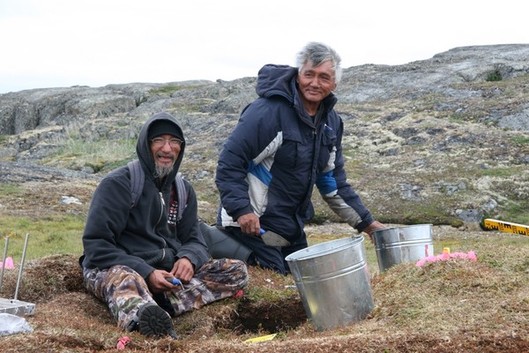Archaeological Research on Smith Island, Summer, 2011
By Pierre M. Desrosiers
During the summer 2011 Avataq Cultural Institute undertook archaeological excavations and field survey on Smith Island, near the community of Akulivik. The project served as a field school for local high school students and it was received by them with great interest: many teenagers applied to participate in this activity. The following students were involved in the field school: Evie Aliqu, Illutak Anautak, Laura Aliqu, Lucassie Aullaluk, Lucy Alasuak, Maggie Irqumia, Okituk Amamatuak, Patric Qiluqi and Tukak Qinuajuak. The camp was run by Simon Makimak with the help of Laina Anauta, Louisa Nappatuk and Davidee Makimak. We were also fortunate to have the special involvement of Willie Kumarluk from Umiujaq, who was responsible for documenting the regional history through interviews and archaeological research. Two students from Laval University, Stéphanie Steelandt and Jonathan Pageau, conducted their graduate research on driftwood and the geomorphology of the island. The Avataq team consisted of Tommy Weetaluktuk, Andrew Papigatuk, David Howard and Pierre M. Desrosiers.
Following our first visit to the island in 2010, we collaborated with the local authorities in selecting the site Kangiakallak (JeGn-2) as the most appropriate location for the field school. The archaeological remains were deposited by two different culture groups, both of whom occupied the site in winter. The Dorset occupants built shallow semi-subterranean houses here, followed later by Thule inhabitants who constructed semi-subterranean sod houses (qarmait). Two structures were excavated: one Dorset and one Thule. Through the excavations we recovered unusually well-preserved artifact assemblages and structural wood. This exceptional preservation permitted the collection of organic tools that are usually absent in archaeological sites in Nunavik.
During the archaeological survey we recorded a large number of Dorset cold season structures on the north-eastern tip of the island, as well as many other sites along the northern shore. It is apparent that the north-eastern point was an important location for winter camps and this is likely associated with a nearby polynia situated between the island and the mainland. One deeply-buried Palaeoeskimo site was also discovered through a test pit (temporary code: AKU-11-20). This site holds great potential for future excavations. In addition, the field school provided the high school students with training in archaeological field methods, as well as introducing them to geomorphology and dendrochronology.







